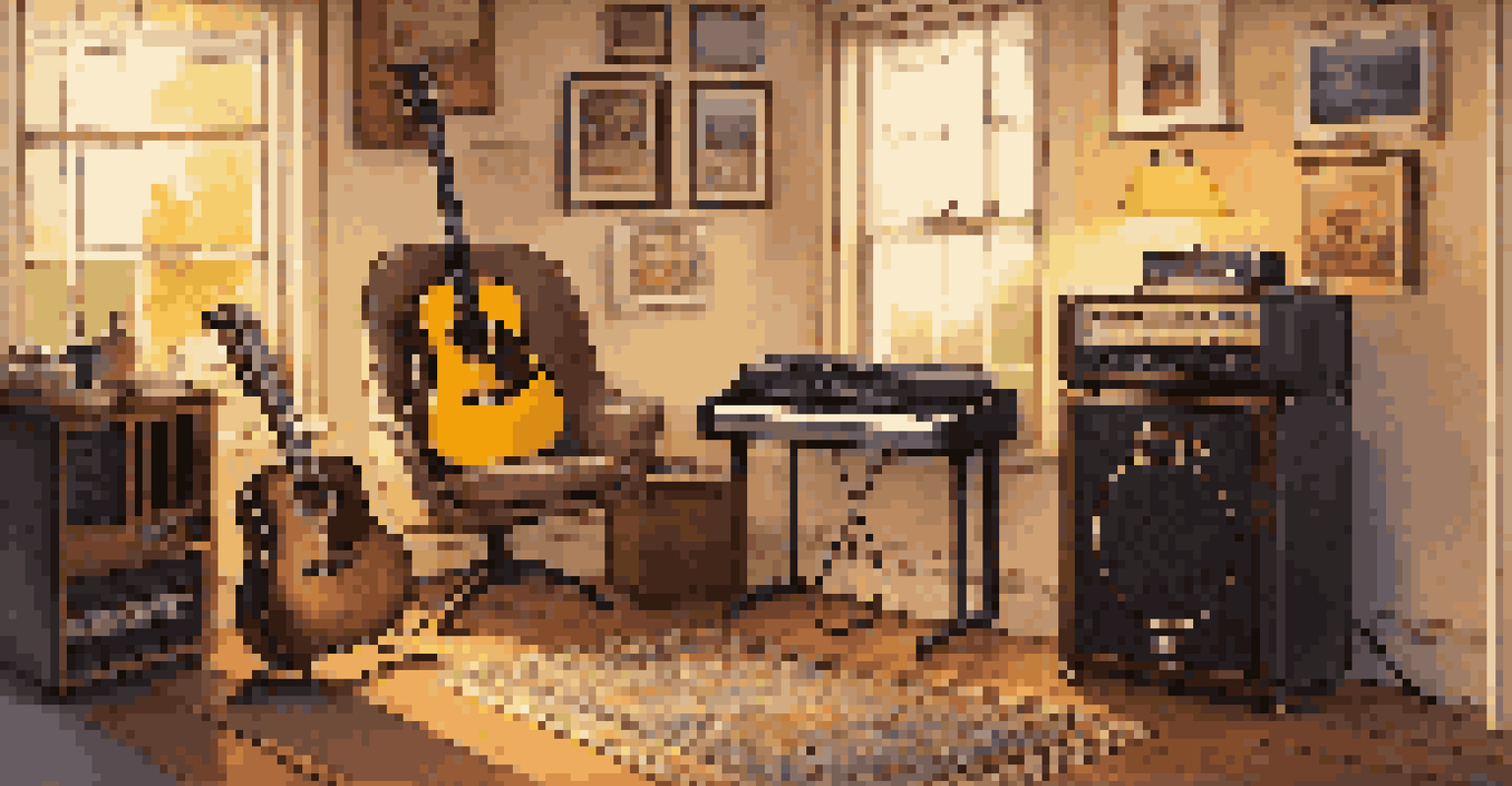Acoustic vs. Electric Music: The Importance of Practice

Understanding Acoustic and Electric Music
Acoustic music is often characterized by its natural sound, produced without electronic amplification. Instruments like the acoustic guitar, piano, and violin rely on physical resonance to create their tones. In contrast, electric music utilizes electronic instruments and amplification, offering a broader range of sounds and effects, such as electric guitars, synthesizers, and digital audio workstations.
Without music, life would be a mistake.
Despite their differences, both styles share a common foundation in musical theory and technique. Whether strumming an acoustic guitar or shredding on an electric, musicians must understand chords, scales, and rhythm. This shared knowledge is crucial in developing versatility as a musician, allowing for fluid transitions between acoustic and electric performances.
Ultimately, both acoustic and electric music bring unique experiences to listeners and players alike. Acoustic music often evokes a sense of intimacy and connection, while electric music can create excitement and energy. Understanding these nuances can enhance a musician's appreciation and approach to practice.
The Importance of Regular Practice
Regular practice is the cornerstone of any musician's journey, regardless of the instrument type. It helps build muscle memory, improve timing, and refine techniques, which are essential for both acoustic and electric players. Just like athletes train to enhance their performance, musicians must dedicate time to hone their skills through consistent practice.

For acoustic musicians, practice often involves mastering fingerpicking patterns, strumming techniques, and vocal integration. For electric musicians, it might mean learning how to operate effects pedals, utilizing feedback, or perfecting solos. In both cases, setting aside time each day to focus on these elements leads to significant progress over time.
Practice is Key for Musicians
Consistent practice builds essential skills and fosters creativity, helping musicians of all styles improve their craft.
Moreover, practice allows musicians to experiment with different styles and genres, broadening their musical horizons. It fosters creativity and encourages exploration, which can lead to the development of a unique sound. This commitment to practice is what truly distinguishes skilled musicians from amateurs.
Finding Your Practice Routine
Creating a personalized practice routine is essential for effective learning. Musicians should assess their goals, whether it's mastering a specific song, improving technique, or preparing for a performance. By breaking these goals into manageable tasks, musicians can make their practice sessions more focused and productive.
Practice does not make perfect. Only perfect practice makes perfect.
For instance, an acoustic guitarist might dedicate one session to finger exercises, while another focuses on learning new chords or songs. Electric guitarists could spend time experimenting with different pedal settings or improvising over backing tracks. Finding a balance between structured practice and creative exploration is vital for growth.
Additionally, consistency is key. Practicing a little each day is often more beneficial than cramming long sessions sporadically. By establishing a routine that fits into one’s lifestyle, musicians can maintain progress and foster a deeper connection with their instrument.
Setting Realistic Goals
Setting realistic goals is an integral part of any practice routine. Musicians should aim for achievable objectives that challenge them without causing frustration. For instance, rather than trying to learn an entire song in one sitting, breaking it down into sections can lead to a more manageable and rewarding experience.
Moreover, celebrating small victories can help maintain motivation. Whether it's perfecting a difficult riff or finishing a challenging piece, acknowledging progress keeps the enthusiasm alive. This positive reinforcement encourages a growth mindset, where musicians view challenges as opportunities for improvement.
Set Realistic Goals for Progress
Achievable objectives motivate musicians and create a roadmap for sustained development in their musical journey.
Ultimately, realistic goals pave the way for sustained practice and development. They create a roadmap for progress, helping musicians stay focused and engaged in their journey, whether on an acoustic or electric instrument.
The Role of Feedback in Practice
Feedback is a crucial component of effective practice, providing musicians with insights into their playing. This can come from various sources, such as teachers, peers, or even self-assessment through recordings. By receiving constructive critiques, musicians can identify areas for improvement and track their progress more effectively.
For instance, an acoustic guitarist might benefit from feedback on their strumming patterns, while an electric guitarist could focus on their tone and dynamics. This exchange of ideas can open doors to new techniques and approaches, enriching the learning experience. Additionally, collaborating with other musicians can inspire creativity and foster a supportive community.
Incorporating feedback into practice helps musicians develop a critical ear and a deeper understanding of their instrument. It encourages them to push beyond their comfort zones and strive for excellence in their craft, no matter which style they pursue.
The Connection Between Practice and Performance
The relationship between practice and performance is essential for musicians. Practice prepares individuals to deliver their best during live shows or recordings. This preparation involves not only mastering the technical aspects of a piece but also developing stage presence and confidence.
For acoustic musicians, the intimacy of a live performance often requires a strong emotional connection with the audience. Electric musicians, on the other hand, may focus more on energy and showmanship, enhancing the overall experience. Regardless of the instrument, practice helps artists find their unique voice and style, which translates into compelling performances.
Feedback Enhances Learning Experience
Constructive feedback from peers and self-assessment is vital for identifying areas for improvement and enriching musical practice.
Moreover, the adrenaline of performing can bring about new challenges, such as managing nerves or unexpected mishaps. Practicing under simulated performance conditions can help alleviate these pressures. By integrating practice and performance, musicians can ensure they are prepared to shine when it matters most.
The Lifelong Journey of Musical Practice
Musical practice is a lifelong journey that evolves as musicians grow and change. Whether someone is just starting with an acoustic guitar or has years of experience with electric music, there’s always room for improvement. This mindset fosters a love for learning and exploration, making music a fulfilling pursuit.
As musicians progress, their practice routines may adapt to include new styles, techniques, or instruments. For example, an acoustic player might transition to electric guitar, discovering new sounds and challenges. Embracing change and remaining open to new experiences can lead to exciting musical adventures.

Ultimately, the importance of practice lies in the joy it brings. It’s not just about mastering skills or achieving goals; it's about connecting with music and expressing oneself. By committing to practice, musicians embark on a rewarding journey filled with creativity, self-discovery, and endless possibilities.